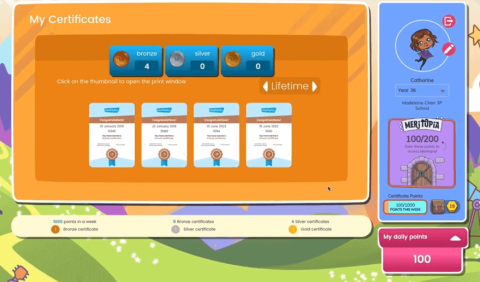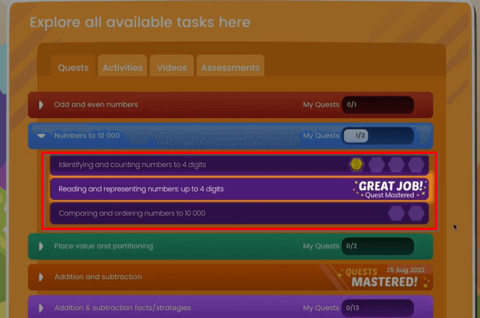Sweaty palms, heavy arms, headaches.
That unpleasant feeling of tension and worry when we see numbers.
Mathematics anxiety is a very real, ever-present condition for many students and can have a lasting impact on students’ learning.
According to a study cited by Professor Daniel Ansari, Canada Research Chair in Development Cognitive Neuroscience, 60 percent of Grade 8 students worry about having difficulty in the subject while 30 percent feel tense when completing mathematics homework.
The Impact of Mathematics Anxiety
Were you ever in a stressful situation where you were so panicked that you couldn’t recall anything?
This is what happens when students experience mathematics anxiety. When students are anxious, it interrupts the working memory. More of their brain power is used to deal with anxiety instead of trying to solve the problem, leading to more errors in their work.
This reduces their capacity and confidence to be successful in the subject. When left unaddressed, it becomes a cycle of fear and avoidance which leads to underachievement and more anxiety, making it even harder for students to overcome.
Teachers’ attitude towards mathematics also impacts the way they teach in class. How confident do you feel about your capabilities and teaching it in class? Did you experience mathematics anxiety growing up?
Your beliefs about your mathematical skills and how to teach it greatly influence how your students learn the subject.
How can Teachers Reduce Mathematics Anxiety?
There is no one cause of mathematics anxiety.
Most of it is rooted in our very own cultural attitudes towards the subject and the nature of our schools and curriculums, such as focusing on speed, timed assessments, and “correctness”, especially in public.
But it doesn’t always have to be this way. There are strategies to reduce children’s mathematics anxiety and rebuild their confidence.
Technology can be a powerful tool in reducing anxiety.
It helps offset the pressure associated with worksheets and makes learning tailored to students’ needs, interests and learning styles.
Games are also effective as it makes learning fun and provide students with incentives for continued practice. Virtual awards like badges, animated progress bars, virtual reward point system, creating personal avatars – these are gamification features in Mathletics to help make mathematics fun and build confidence.
Not every student is a fan of learning numbers, algebra or graphs.
That is why Mathletics believes in making mathematics engaging, stress-free and fun! Here are six ways how you can use Mathletics to combat mathematics anxiety in students.
How Mathletics Reduces Mathematics Anxiety
1. Personal learning environment for each student
Mathletics makes it easy for teachers to ensure that every student in their class is accessing curriculum aligned content at their level of proximal development.
Teachers can group students and set the right courses to ensure they are able to achieve success and make progress. Students are presented with a personal learning environment that isn’t labelled with their curriculum level. This ensures students aren’t compared with their peers.
2. Rewards and recognition to inspire confidence

Every student is rewarded for their effort and can earn points and certificates, regardless of where they stand next to their peers.
They can earn certificates by achieving 1000 points in a week. With the appropriate curriculum assigned to each student’s level, this makes it more achievable for students to earn weekly certificates, boosting their morale and confidence in their mathematical ability.
3. Balance of assigned and independent work
Mathletics provides students with the right mix of assigned work and independent work. Students have access to content which enables them to practice independently, choosing the tasks that they want to improve on.
In the core Mathletics activities, a familiar traffic lighting system enables students to visually understand which activities they have mastered and which they need to come back to and practice some more. In addition, teachers can assign work to students, provide targeted and focused work aligned to lesson outcomes.
4. Empower students to take ownership

Mathletics gives students the opportunity and tools to take ownership of their own learning.
Students can see their progress and are encouraged to work on activities they find difficult. They’re rewarded with more credits when they improve their scores, motivating them to master these activities.
5. Confidential and direct feedback
When mistakes are made, students receive immediate feedback and are shown the correct answer in Mathletics. They can also access support when needed and be guided through errors made in their activities.
When working on Quests, teachers are notified of any students that have made 5 errors within one level of a Quest, enabling them to provide timely support.
When students are working on Challenges, they can send a message, written or recorded to their teacher privately. By giving students a safe platform to ask for help without the request being visible to their peers, it reduces any added anxiety.
6. Deepens understanding and fluency
Mathletics helps students build strong foundational skills through the Understanding, Practice and Fluency (UPF) learning journeys. The UPF learning journeys follow a series of curriculum-aligned questions that continually adapt to match to their ability.
Live Mathletics encourages practice to develop fluency in key mathematics facts.
In Mathletics activities, the ‘i’ button guides students through questions to provide support and increase understanding. Plus the use of mathematical models and images within tasks present concepts in a varied way, helping all types of learners deepen their understanding.
Overcoming Mathematics Anxiety
There are a variety of factors that negatively influence a student’s view of mathematics.
The first and most important step is to be aware of the signs and address them. Once you have identified the students that need more attention, come up with strategies and test them. Compare strategies with your colleagues to get insights and fresh ideas. Get parents onboard and involved too.
Overcoming mathematics anxiety is not something that can be resolved quickly.
Change takes time, practice and patience. However, with continued support, engaging resources and positive reinforcement, it can be done!








